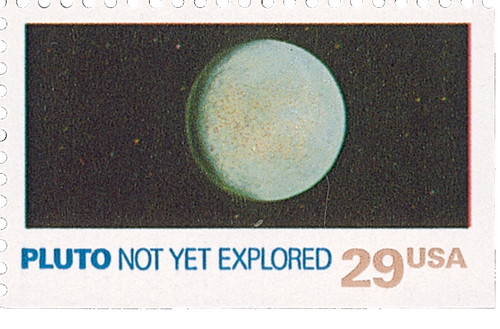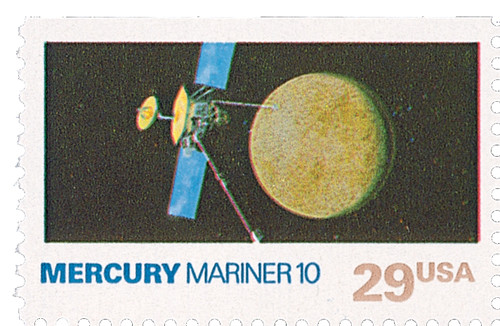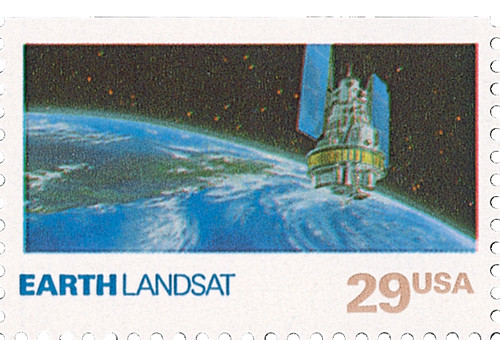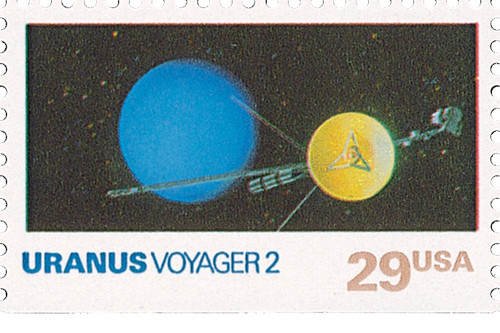
# 2577 - 1991 29c Space Exploration: Pluto
US #2577
1991 Pluto
- Part of set picturing nine planets and Earth’s moon
- Issued as part of Stamp Collecting Month
Category of Stamp: Commemorative
Set: Space Exploration
Value: 29¢
First Day of Issue: October 1, 1991
First Day City: Pasadena, California
Quantity Issued: 33,394,800
Printed by: Bureau of Engraving and Printing
Printing Method: Photogravure
Format: Booklets – 2 panes of 10 in each
Perforations: 11
Reason the stamp was issued: The set of Space Exploration stamps was issued in honor of the Voyager 2 space probe passing Neptune and the 11th annual Stamp Collecting Month.
About the stamp design: The Pluto stamp pictures the planet the words “Not Yet Explored.”
These stamps were the first by Ron Miller, a former artist for the Smithsonian Institution’s National Air and Space Museum. He was asked to picture each of the Sun’s nine planets and the Earth’s moon with a spacecraft. This was to tie in the idea of America’s exploration of space. His original acrylic paintings were larger than those normally used for stamp art. This was to show all the details of the spacecraft.
Special design details: While most of the stamps name the spacecraft shown, the Pluto stamp has “not yet explored,” because no spacecraft had reached that planet at the time. (The space probe New Horizons explored Pluto in 2015.)
First Day City: The First Day of Issue ceremony took place at the Jet Propulsion Laboratory in Pasadena, California, on October 1, 1991, the start of Stamp Collecting Month.
Unusual thing about this stamp: The USPS partnered with Paramount Studios to promote the stamps. The studio was celebrating the 25th anniversary of the Star Trek movies and television series. The stamp designs were unveiled on the bridge of the Starship Enterprise, the space vehicle featured in the series. Flyers promoting the stamps were included in the packaging of Star Trek video cassettes.
About National Stamp Collecting Month stamps: October has been designated by the US Postal Service as National Stamp Collecting Month. The first celebration occurred in 1981 as a way to promote the hobby of collecting stamps. Each year, new stamps are issued in early October to stimulate additional interest, and many philatelic organizations hold special programs during the month. The theme for the 1991 celebration was “Journey to a New Frontier… Collect Stamps.”
History the Space Exploration stamps represent: Uncovering the mysteries of the universe has been a pursuit of scientists and dreamers for all time. With the invention of telescopes, astronomers discovered some of the wonders of space. With the space age, researchers began sending spacecraft outside of Earth’s orbit to gain further insight into the planets of our solar system. Manned missions were followed by unmanned missions with the capability of traveling to distant planets. These stamps show some of the spacecraft and the images of the planets they captured as they flew by. Discoveries continue to be made with the space probes that still travel through our solar system.
How a postage stamp inspired a mission to Pluto
Scientists had long dreamed of exploring Pluto. It was the issuing of a postage stamp that served as a rallying point to launch a mission to the most distant planet in our solar system.
The Voyager mission did its final flyby of Neptune in 1989. Two years later, the USPS issued a set of stamps (U.S. #2568-77) featuring each of the planets with the spacecraft that explored it. But one stamp stood out. Picturing a lone planet, it proclaimed, “Pluto: Not Yet Explored.” The statement was taken as a challenge.
NASA created the New Horizons mission with plans to explore Pluto, its moons, and objects beyond them. The mission launched in January 2006, just seven months before Pluto was reclassified as a dwarf planet. The fastest spacecraft ever built, New Horizons traveled to Pluto at an astounding 96,000 miles per hour.
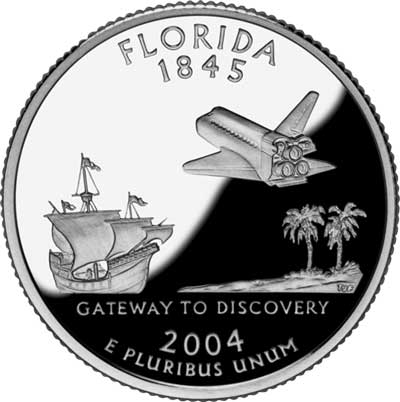
The probe carried a number of artifacts into space. These include a U.S. flag, a Florida state quarter (which honors space exploration), and the 1991 stamp that inspired the mission. New Horizons reached Pluto on July 14, 2015. The same day, the probe began transmitting back the first batch of data, including the first up-close images we have ever seen of Pluto.
Journeying more than 2.6 billion miles from Earth, the probe transmitted data at a very slow rate, so scientists continued to receive new data about Pluto for more than a year. The mission allowed them to calculate Pluto’s exact diameter, view mountains, plains, and ice caps, and see the planet has a reddish hue from the compounds in its atmosphere. They also found that Pluto’s atmosphere is being blown into space by solar winds, creating a tail of plasma. Because of Pluto’s nearly round shape, scientists suspect the now-frozen planet once had a warm subsurface and a liquid ocean.
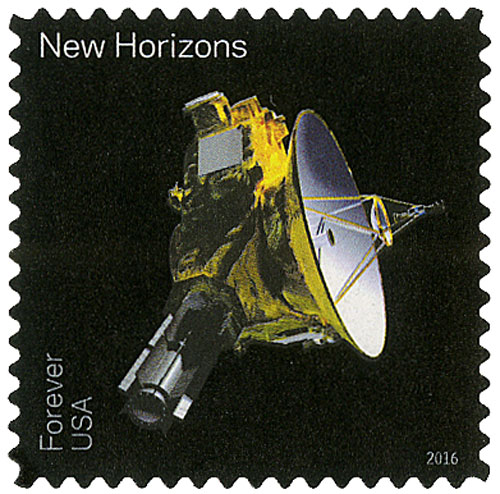
All of this new data revealed that Pluto has been changing for much of its existence, contrary to what scientists have long believed. The images showed curious cone-shaped mountains with craters in the center and a potential nitrogen-spewing ice volcano, the only one of its kind to be discovered in our solar system.
New Horizon’s next goal is to discover more of the Kuiper Belt. But Pluto’s exploration has already made the mission a resounding success.
US #2577
1991 Pluto
- Part of set picturing nine planets and Earth’s moon
- Issued as part of Stamp Collecting Month
Category of Stamp: Commemorative
Set: Space Exploration
Value: 29¢
First Day of Issue: October 1, 1991
First Day City: Pasadena, California
Quantity Issued: 33,394,800
Printed by: Bureau of Engraving and Printing
Printing Method: Photogravure
Format: Booklets – 2 panes of 10 in each
Perforations: 11
Reason the stamp was issued: The set of Space Exploration stamps was issued in honor of the Voyager 2 space probe passing Neptune and the 11th annual Stamp Collecting Month.
About the stamp design: The Pluto stamp pictures the planet the words “Not Yet Explored.”
These stamps were the first by Ron Miller, a former artist for the Smithsonian Institution’s National Air and Space Museum. He was asked to picture each of the Sun’s nine planets and the Earth’s moon with a spacecraft. This was to tie in the idea of America’s exploration of space. His original acrylic paintings were larger than those normally used for stamp art. This was to show all the details of the spacecraft.
Special design details: While most of the stamps name the spacecraft shown, the Pluto stamp has “not yet explored,” because no spacecraft had reached that planet at the time. (The space probe New Horizons explored Pluto in 2015.)
First Day City: The First Day of Issue ceremony took place at the Jet Propulsion Laboratory in Pasadena, California, on October 1, 1991, the start of Stamp Collecting Month.
Unusual thing about this stamp: The USPS partnered with Paramount Studios to promote the stamps. The studio was celebrating the 25th anniversary of the Star Trek movies and television series. The stamp designs were unveiled on the bridge of the Starship Enterprise, the space vehicle featured in the series. Flyers promoting the stamps were included in the packaging of Star Trek video cassettes.
About National Stamp Collecting Month stamps: October has been designated by the US Postal Service as National Stamp Collecting Month. The first celebration occurred in 1981 as a way to promote the hobby of collecting stamps. Each year, new stamps are issued in early October to stimulate additional interest, and many philatelic organizations hold special programs during the month. The theme for the 1991 celebration was “Journey to a New Frontier… Collect Stamps.”
History the Space Exploration stamps represent: Uncovering the mysteries of the universe has been a pursuit of scientists and dreamers for all time. With the invention of telescopes, astronomers discovered some of the wonders of space. With the space age, researchers began sending spacecraft outside of Earth’s orbit to gain further insight into the planets of our solar system. Manned missions were followed by unmanned missions with the capability of traveling to distant planets. These stamps show some of the spacecraft and the images of the planets they captured as they flew by. Discoveries continue to be made with the space probes that still travel through our solar system.
How a postage stamp inspired a mission to Pluto
Scientists had long dreamed of exploring Pluto. It was the issuing of a postage stamp that served as a rallying point to launch a mission to the most distant planet in our solar system.
The Voyager mission did its final flyby of Neptune in 1989. Two years later, the USPS issued a set of stamps (U.S. #2568-77) featuring each of the planets with the spacecraft that explored it. But one stamp stood out. Picturing a lone planet, it proclaimed, “Pluto: Not Yet Explored.” The statement was taken as a challenge.
NASA created the New Horizons mission with plans to explore Pluto, its moons, and objects beyond them. The mission launched in January 2006, just seven months before Pluto was reclassified as a dwarf planet. The fastest spacecraft ever built, New Horizons traveled to Pluto at an astounding 96,000 miles per hour.

The probe carried a number of artifacts into space. These include a U.S. flag, a Florida state quarter (which honors space exploration), and the 1991 stamp that inspired the mission. New Horizons reached Pluto on July 14, 2015. The same day, the probe began transmitting back the first batch of data, including the first up-close images we have ever seen of Pluto.
Journeying more than 2.6 billion miles from Earth, the probe transmitted data at a very slow rate, so scientists continued to receive new data about Pluto for more than a year. The mission allowed them to calculate Pluto’s exact diameter, view mountains, plains, and ice caps, and see the planet has a reddish hue from the compounds in its atmosphere. They also found that Pluto’s atmosphere is being blown into space by solar winds, creating a tail of plasma. Because of Pluto’s nearly round shape, scientists suspect the now-frozen planet once had a warm subsurface and a liquid ocean.

All of this new data revealed that Pluto has been changing for much of its existence, contrary to what scientists have long believed. The images showed curious cone-shaped mountains with craters in the center and a potential nitrogen-spewing ice volcano, the only one of its kind to be discovered in our solar system.
New Horizon’s next goal is to discover more of the Kuiper Belt. But Pluto’s exploration has already made the mission a resounding success.

